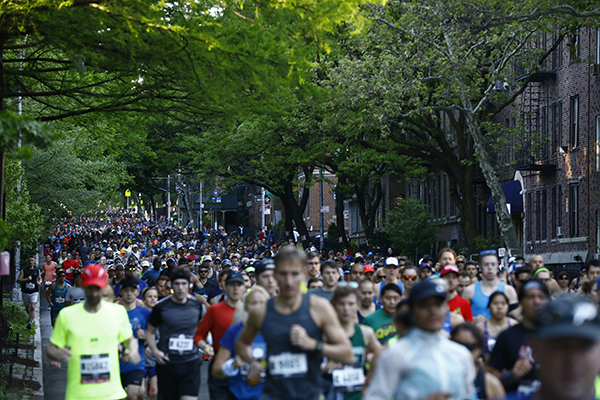¿Está listo para correr una media maratón?

Are you training for the United Airlines NYC Half this March? Or perhaps you've signed up for the SHAPE + Health Women's Half Marathon in April, or entered the drawing for the RBC Brooklyn Half in May.
There are loads of good reasons to run a half (13.1 miles). Let's look at why—and how—to tackle this distance, from training through to the finish line!
What’s So Great About Running a Half?
The half marathon is the second most-popular racing distance in the country (after the 5K) according to Running USA. Globally there were about 2.1 million half marathon participants in 2018, according to the International Institute for Race Medicine’s State of Running 2019 report.
The half-marathon distance is impressive, yet the preparation and race day are manageable, with most training plans lasting about 10 weeks and the average finishing time in the range of two hours, 10 minutes. Contrast this with a training cycle of 12-20 weeks for a marathon (26.2 miles) and an average finishing time of 4 hours, 39 minutes for the 2021 TCS New York City Marathon.
How Can You Prepare?

There are lots of great half marathon training tools out there, including:
NYRR Coaching Lab by Runcoach, a personalized app
NYRR Group Training, in-person coached workouts and long runs in NYC
NYRR free training guides
How Do You Know You’re Ready—Or Getting There?
Half-marathon training focuses on gradually building up your body’s ability to run long distances. You don’t need to work a lot on your speed—no need for fast laps around a track or sprints up and down a football field. Rather, you need to extend your longest weekly run to a couple of hours—and take your time doing that, giving yourself two to three months. Your other runs during the week can be in the 30- to 60-minute range.
For example, you could run for 45 minutes each on Tuesdays and Thursdays, and an hour or longer (building up to two hours) on Saturday or Sunday.
Are There Any Shortcuts?
Like the marathon, the half marathon is a distance that’s hard to fake your way through. If the training isn’t there, you may severely fatigue on race day, especially after about 9 or 10 miles. But read on—there are a couple of ways to get through your 13.1 miles in one piece even if your training hasn’t been ideal.
How to Have an Awesome Race Day

If race day is drawing near and you're not quite ready, what should you do? We have two suggestions:
One, you can plan to complete the distance by taking short walking breaks at regular intervals—for example, walk 1-2 minutes at every mile marker. This will conserve your energy and save the pounding on your legs that can cause cramping or injury, reducing you to a permanent shuffle.
Two, you can find a friend who also feels less than ideally prepared and plan to complete the race together, supporting each other along the way. The camaraderie will go a long way toward keeping both of you motivated!
Keep in mind you can cancel your entry and plan to run a future half marathon, allowing yourself more time to prepare. This is your best option if you’re injured or have been ill. Running 13.1 miles with an injury risks making the problem worse. With in-person races back in full force in most places and virtual racing thriving, there are plenty of other opportunities ahead.